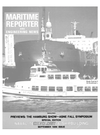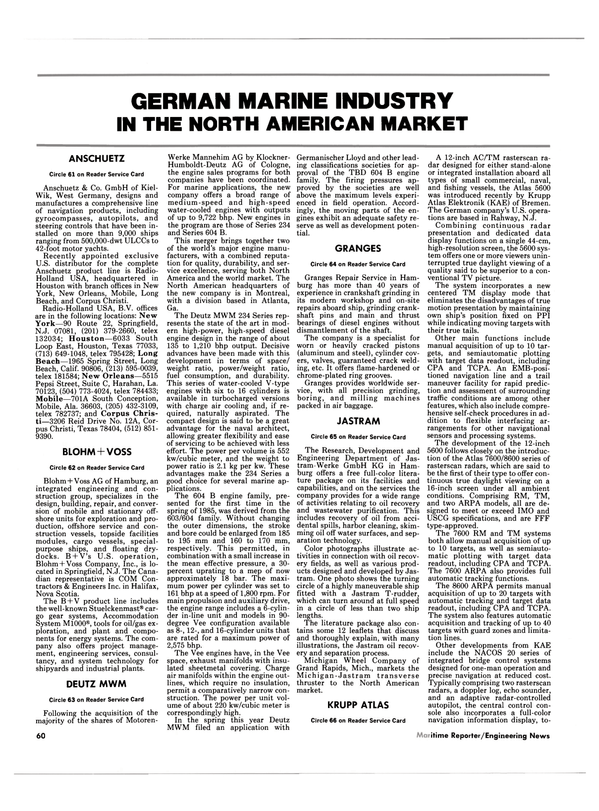
Wartsila Diesel Reviews Methods For Re-Engining
—Literature Available— The revolutionary development of the medium-speed diesel engine with improved total economy, has created an opportunity for the reengining of many vessels. The main aspects of improved economy offered by medium-speed diesel engines are: capacity to burn heavy fuels of almost any quality at all loads; low fuel consumption at all loads (with an advantage of as much as 15 to 25 g/kwh when compared with older engines); and long overhaul intervals and reduced maintenance costs.
With the development of the medium- speed diesel engine, a number of shipowners became aware of the potential cost-saving advantages of re-engining, and began to re-engine not only older ships, but in some cases, new ones as well.
A few years ago, Wartsila Diesel of Finland, one of the leaders in the re-engining market, decided to review its experiences in re-engining projects, and formulate methods for making the process both easy and straightforward for the shipowner.
Wartsila found in its review that: • Operation on heavy fuel is profitable as long as the price difference between heavy fuel and distillate is a few dollars; operation is of course more profitable with a wider price gap. Increased consumption of oil products will probably further widen the gap.
• A detailed feasibility study must precede the decision to reengine.
• The pay-back time can be calculated from the annual operating costs of the old and new machinery, the estimated re-engining cost, and the capital cost terms. Most shipowners consider re-engining when the pay-back time is in the area of two or three years. Projects carried out by Wartsila Diesel to date, have had an average pay-back time of two years.
• Even when the pay-back period is acceptable, a negative cash flow is not. That is why an important goal of Wartsila Diesel has been to show a positive cash flow for every fiscal year.
Wartsila Diesel's aim has been to develop the capacity to install one or more new auxiliary engines or alternator sets without taking a ship out of its normal sailing schedule.
The idea is that the taking-in of the equipment is preplanned, and performed during a normal stay in port, and the installation of the engine and the systems is performed at sea.
The installation work can be simplified by the use of preplanned system modules tailor-made to a particular ship.
However, since main engines cannot be replaced without stopping the ship, reducing off-hire time as much as possible is essential. Preplanning the change process thoroughly is time-saving. Wartsila reports that when the working hours for each stripping level are known, the size of the opening needed to take in the engine can quickly be optimized. A small opening means a little more assembly work on the engine, while a big opening may mean more work on the ship itself.
Wartsila Diesel has formulated methods for performing every aspect of re-engining, from feasibility studies to complete projects, and can also work effectively with partners.
Feasibility studies are often made by outside consultants, either by a shipowner's appointment or Wartsila's request. Wartsila also offers supervisory services when a job is performed by other ship service companies or shipyards. Project planning and negotiations with shipyards and equipment suppliers are services which are also offered by Wartsila.
For further information, including free detailed literature on Wartsila Diesel re-engining services and facilities, Circle 28 on Reader Service Card
Read Wartsila Diesel Reviews Methods For Re-Engining in Pdf, Flash or Html5 edition of September 1986 Maritime Reporter
Other stories from September 1986 issue
Content
- Wartsila Becomes Major Shareholder In Wichmann —New Company Formed page: 4
- Kabel And Jepsson Named Vice Presidents For Wartsila Diesel page: 6
- Tideland Signal Offers Free 30-Page Brochure On Aids To Mavigation For Ports And Harbors page: 6
- Lucian Q. Moffitt Offers Paper On New Water Lubricated Rubber Bearing Materials/Applications page: 6
- New Hull Cleaning System Brochure Offered By VEB Kombinat Schiffbau page: 6
- Hull Built By Wdrtsild-Turku Will Be Outfitted By Moss Yard page: 6
- World's Largest Clamshell/Dipper Dredge To Be Delivered This Year To Great Lakes International page: 7
- CDI Marine Names Eason VP, Operations-West page: 8
- Wartsila Wins $122-Million Contract To Build Big Cruise Ship For Kloster page: 8
- Wilson Walton Introduces Improved Version Of Aquamatic Impressed Current Cathodic Protection System page: 8
- Keel Laid At Todd San Pedro Yard For Matsonia's New Midbody Section page: 10
- Pennsylvania Shipbuilding Contracts With Siemens For PTO Generators page: 11
- St. Philip Towing Announces Sale Of Oceangoing Tug And Barge Fleet page: 11
- Blount Delivers Commuter Ferry For High-Speed Hudson Crossings page: 12
- Aquamaster Propulsion Units Installed In Self-Unloading Malaysian Bulker page: 12
- Eastern Marine Delivers Passenger Vehicle Ferry 'Anna C.' To Nelseco Navigation Company page: 14
- COMSAT Marks 10 Years Of Commercial Maritime Satellite Communications page: 14
- Stolt-Nielsen Ship Management Moves To Panama City, Fla. page: 15
- Chevron Offers Free Color Guide To Inland & Coastal Marine Lubricants page: 15
- SMM '86 Ship, Machinery and Marine Technology International Trade Fair page: 16
- Detroit Diesel And Deere Plan Joint Venture To Market Broader Line Of Diesel Engines page: 22
- MonArk Boat Delivers First of Nine Fast Parasail Craft For Air Force page: 22
- Two Separate Divisions Formed From Textron's Bell Aerospace Operation page: 24
- Fairbanks Morse Engine Division Unveils New Test Facility page: 24
- Eggert Appointed Sales & Operations Coordinator For Cleveland Tankers page: 25
- New Color Brochure From A.W. Chesterton Details Process Seals page: 25
- Richfield Marine Agencies Merges As Subsidiary Of QAF Limited Of Brunei page: 25
- Navy Awards Ingalls $221.8 Million For Battleship Modernization page: 26
- New Marine Repair Firm Established page: 28
- Magnavox Names Manager Of Marketing Services page: 28
- U.S. NAVY SHIP PROCUREMENT page: 31
- MAJOR NAVY CONTRACTS page: 37
- Defense Department's First Two-Year Budget Cycle To Begin For FY88 page: 37
- Avondale Christens Replenishment Fleet Oil Building For U.S. Navy page: 42
- Research Ship For NATO Launched At Muggiano Yard of Fincantieri-CNI page: 45
- Sealift Command Plans To Purchase Additional Ships For Ready Reserve Fleet page: 46
- MSC To Procure Up To Six Logistic Support Vessels For U.S. Army page: 46
- ASNE/NAVY SYMPOSIUM AND EXHIBITION 1986 page: 50
- Imperial And Parkway Consolidate Operations page: 53
- Moore McCormack Plans Sale Of Its Two Bulk Shipping Subsidiaries page: 53
- "Financial Times' To Issue Survey On World Ports page: 53
- Westport Yard Delivers Multipurpose Fiberglass Excursion/Fishing Vessel page: 56
- Sperry Joins With Marine Management To Offer Total Computing System page: 57
- Meyer Werft Delivers Fifth Passenger Ship Built For Indonesia page: 57
- Wartsila Diesel Reviews Methods For Re-Engining page: 58
- Todd S h i p y a r d s Board Elects T w o Top E x e c u t i v e s A nd Reports P r o f i t a b l e Quarter page: 59
- N e w Intertanko Publication ' T a n k e r Port Particulars 1986' Is N o w A v a i l a b le page: 59
- GERMAN MARINE INDUSTRY IN THE NORTH AMERICAN MARKET page: 60
- Sperry MCS2B SatCom INMARSAT Type Approved page: 65
- Equipment Engineering Offers Hydraulic Disc Compression Tool page: 69
- LaGrange And Wyne Appointed At Louisiana Dock's Harahan Yard page: 73
- American Hawaii Cruises Names Bennett And Thomason To Senior Management Posts page: 73
- Patti Shipyard Delivers Excursion Vessel 'Mississippi Belle IT page: 74
- No Need To Remove Shaft For Bearing Change With Duramax Demountable Bearings page: 79
- Greater New Orleans Barge Fleeting Association Seminar Set For October 2, 3, And 4 page: 79
- Major Appointments Announced By Versatile Of Canada page: 79
- Unaflex Introduces New Molded Expansion Joints page: 79


